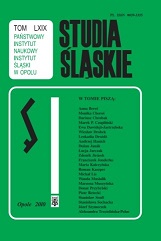Inwestycje zagraniczne na Śląsku Opolskim 1989–2009
Foreign investments in Opole Silesia 1989–2009
Author(s): Stanisław SenftSubject(s): History
Published by: Instytut Śląski
Keywords: foreign investments; Opole Silesia; 1989-2009; international companies
Summary/Abstract: The appearance of foreign enterprises and international companies made, after 1989, for a vital factor in the then economic changes and new directions of cooperation. Although the first formal legal frameworks which made the flow of foreign capital as well as establishing firms with its participation possible had already been formed in the period of declining People’s Republic of Poland, still it was the transformation that followed after the fall of the real socialism which sped up that process, which – additionally – was facilitated by appropriate legislation. A particularly dynamic growth in the number of companies with foreign capital took place in the first decade (1991–2000); at the beginning of the 21st century it was relatively less significant. Opole Province did not and does not belong to particularly attractive areas for investment in Poland. It does, however, distinguish itself by a peculiar character that results from the past of the Region, the origin of a part of its inhabitants and family connections with relatives living abroad. The number of economic units, most frequently in the form of joint venture companies with limited liability, amounted to 39 towards the end of 1991, in 1995–to 525, in 2000 – to 991, and in December 2009 – to 1354. They were established, primarily, in large urban centers and in the counties and communes which are, in their majority, inhabited by the native population. From the very beginning there dominated the German capital, not only as regards the number of firms, but also the engaged start-up capital. With only a few exceptions there prevailed small and medium-sized enterprises which can be classified as typical family-run companies. They played a positive role in the activation of local markets, yet could not be the ‘driving wheel’ for the economy as a whole. Initially, in the branch structure, there dominated industrial and craft production, later – due to the construction of new supermarkets – trade was in the lead. The foreign capital appears also in construction industry, hotel and gastronomic services, and branches such as transport, banking, social insurance and the mass media.
Journal: Studia Śląskie
- Issue Year: 2010
- Issue No: 69
- Page Range: 55-66
- Page Count: 12
- Language: Polish

